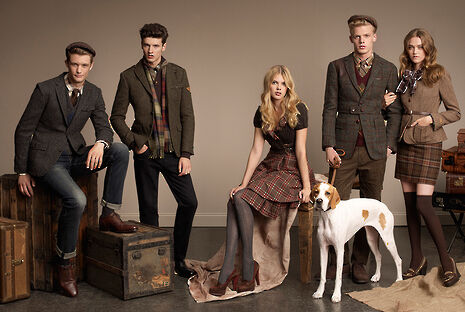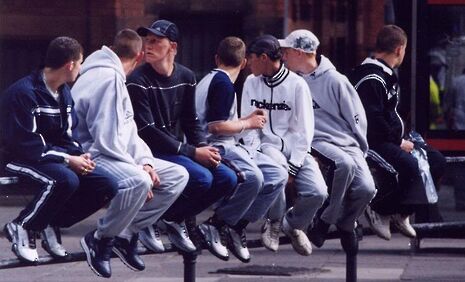An outsider’s view on British fashion
How Ralitsa Belcheva learned to stop worrying and love the corduroy

Before I boarded my flight to Cambridge, I had a very peculiar idea of what constituted British fashion – shaped primarily by photos of Kate Middleton, late night viewings of Geordie Shore and Monthy Python, and a rather unfortunate visit to the Primark in Westfield the day after my interview. However, once I had settled in, and had gotten over the initial shock of moving half a continent away, I had some time to test my previous hypothesis about fashion.
In many ways, I was proven right – Cindies at midnight is a pretty good mix of Geordie Shore, Monthy Python and Primark, with the odd Kate Middleton dropping by after formal. But in many other ways I was wrong – British fashion is far more refreshing and liberating than anything I could have experienced back home in Eastern Europe.
Fashion back home
Fashion in Eastern Europe is a multifaceted, yet oddly conservative thing, shaped by years of history, ideology and foreign influence. There are three main historical trends, which have shaped the approach towards clothing among the fashion-conscious: the bare bones approach under communism, the foreign-inspired extravagance of the 90s and 2000s, and the counter-cultural movement that started in the 80s.
The way I was taught to think about fashion was deeply rooted in austerity – I was taught to value good cuts, good fabrics, a nice body, and well-maintained hair. There was little room for self-expression (save for a couple of years of teenage rebellion). In many ways, this is the result of how unusually involved my grandparents were in my upbringing – and this idea of fashion is widespread among those in their 30s-40s, as well as the millennial children of older parents. It is rooted in the way life was structured under communism – you needed things to last – you didn’t know if and when you might get much else.
The second, most prevalent way of approaching fashion is the blind adoption of trends from Western ads, magazines, TV series, etc. This finds its origins in the time directly after the fall of the Berlin Wall, when images of the successful, rich West came flooding into the chaotic, crisis-fuelled first years of capitalism. This gave birth to the mafia-chic of the 90s, the hip-hop-inspired fashion of the 2000s, and the cult following of beauty bloggers in recent years.

Finally, there are those who disregard conventional fashion entirely – ever since the 80s there has been a undercurrent of people dressing primarily in DIY and thrift store clothing. However, trends created in this sphere rarely catch on and become mainstream because of the small number of local fashion magazines which can promote them, and the relatively small number of people who wear them.
There is a big focus on body image – due to the Soviet Union's influence, there is still the cultural remnant of signing up three or four-year-old girls for ballet, volleyball or gymnastics, where weight is policed by the coaches; and which, coupled with mandatory sports education until graduation, creates unreasonable expectations. And for boys, there is the thriving scene of semi-legal protein powders in the practically mandatory gyms.
This odd amalgamation of circumstances has given birth to a Frankenstein of a fashion scene, which puts a considerable emphasis on cut and fabric, but can sometimes be garish, which rarely creates new trends, but is eager to adopt outside trends with minimal modification. So imagine me, in heels and a tailored skirt, on her first day of lectures at Sidgwick… it was a bit of a shocker, to say the least. But in the following weeks three things stood out to me as really different, though originally, my opinions were not as kind as they are now!
The freedom to choose your own style – even when you have no idea what you’re doing
For every person with stunning personal style, there seems to be another who looks, shall we say, a little startling. However, what is undeniable is the confidence which people have, even when preposterously dressed, and the ease with which they carry themselves. What was particularly surprising was the speed with which retailers stock up on new clothing inspired by successful street style trends, and the speed with which those trends spread once on the racks. Having local magazines and an appreciation for the way people dress on the streets make for a faster turnover of styles and a more vibrant fashion scene.
Body positivity and unfitted clothing
Back home, everything is fitted – either because it is the proper thing to do, or because you want to show off as much of your body as you can. However, here, it matters much less whether your clothes fit, and whether they’re ‘suited’ to your body type. Here, a more body positive culture translates into a gain in self-confidence and happiness. If wearing size 20 white jeans makes someone happier than wearing black ones, then I think fashion has achieved its purpose.
The seeming lack of class distinction in clothing
Back home, there is a noticeable class distinction – you can tell the nouveau riche apart from the intellectual elite, the intellectual elite from the middle class and the middle class from the poor by the clothes they wear. Here, it doesn’t seem as simple – everyone wears fast fashion, and the popularity of street style (and champagne socialism) makes it harder to discern class. There are indicators – bespoke tailoring, better quality items – but overall, if one doesn’t have their own specific personal style, they dress indistinguishably from everyone else, at least when they’re young.
East meets West
Despite the differences, there are a growing number of similarities between British fashion and the clothes worn back home. Global retailers are gaining ground in Eastern Europe, and local fashion magazines are not the only source of fashion news anymore – with the advent of YouTube, fashion and makeup bloggers have made styling choices more similar, especially among teenagers. However, historical attitudes and the unflinching hold of unachievable body standards are still present.
This is in many ways about globalisation – global fashion is becoming more accessible, but it is also strong evidence of culture influencing fashion. Is culture going to blend across borders? Or is it going to become more based on personal expression than nationality?

Questions of cultural appropriation notwithstanding, there is value in borrowing styles from the places you visit – not only the harem pants from your ‘gap yah’ in Thailand, but also the careful cuts of Eastern Europe, and vintage UK fabrics. It creates a fuller experience of fashion – even if it means straying from mass-market shops.
As for myself, I no longer clutch my proverbial pearls when I see a particularly outrageous culottes and peacoat combo around Sidgwick. I’ve learned to accept some of the freedom of British fashion – and this has made me more comfortable in my own skin – but sometimes I miss dressing to the nines every day, and I miss accessible tailoring. What I don’t miss are the crash diets, the endless shopping trips and the constant pressure to look good.
Almost a year in, I can admit I’ve betrayed my roots, a little – I own clothes made out of tweed and corduroy, and a Primark shimmery top
 News / Fitz students face ‘massive invasion of privacy’ over messy rooms23 April 2024
News / Fitz students face ‘massive invasion of privacy’ over messy rooms23 April 2024 News / Climate activists smash windows of Cambridge Energy Institute22 April 2024
News / Climate activists smash windows of Cambridge Energy Institute22 April 2024 News / Copycat don caught again19 April 2024
News / Copycat don caught again19 April 2024 News / Emmanuel College cuts ties with ‘race-realist’ fellow19 April 2024
News / Emmanuel College cuts ties with ‘race-realist’ fellow19 April 2024 Comment / Does Lucy Cavendish need a billionaire bailout?22 April 2024
Comment / Does Lucy Cavendish need a billionaire bailout?22 April 2024





